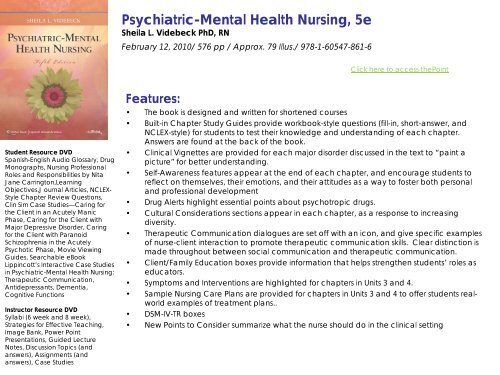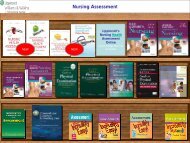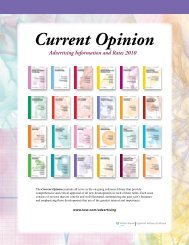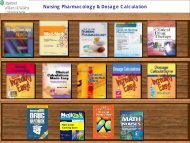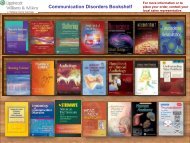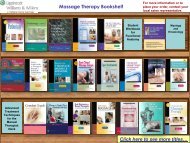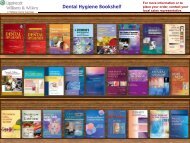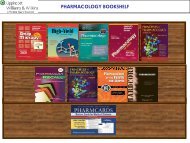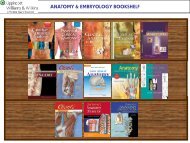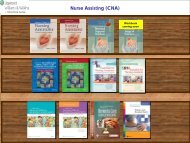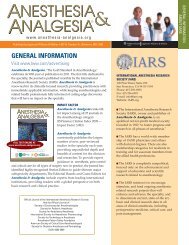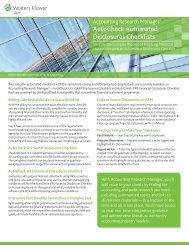Psychiatric â Mental Health Nursing - Lippincott Williams & Wilkins
Psychiatric â Mental Health Nursing - Lippincott Williams & Wilkins
Psychiatric â Mental Health Nursing - Lippincott Williams & Wilkins
Create successful ePaper yourself
Turn your PDF publications into a flip-book with our unique Google optimized e-Paper software.
<strong>Psychiatric</strong>-<strong>Mental</strong> <strong>Health</strong> <strong>Nursing</strong>, 5eSheila L. Videbeck PhD, RNFebruary 12, 2010/ 576 pp / Approx. 79 Illus./ 978-1-60547-861-6Click here to access thePointStudent Resource DVDSpanish-English Audio Glossary, DrugMonographs, <strong>Nursing</strong> ProfessionalRoles and Responsibilities by NitaJane Carrington,LearningObjectives,J ournal Articles, NCLEX-Style Chapter Review Questions,Clin Sim Case Studies—Caring forthe Client in an Acutely ManicPhase, Caring for the Client withMajor Depressive Disorder, Caringfor the Client with ParanoidSchizophrenia in the AcutelyPsychotic Phase, Movie ViewingGuides, Searchable eBook<strong>Lippincott</strong>’s Interactive Case Studiesin <strong>Psychiatric</strong>-<strong>Mental</strong> <strong>Health</strong> <strong>Nursing</strong>:Therapeutic Communication,Antidepressants, Dementia,Cognitive FunctionsInstructor Resource DVDSyllabi (6 week and 8 week),Strategies for Effective Teaching,Image Bank, Power PointPresentations, Guided LectureNotes, Discussion Topics (andanswers), Assignments (andanswers), Case StudiesFeatures:• The book is designed and written for shortened courses• Built-in Chapter Study Guides provide workbook-style questions (fill-in, short-answer, andNCLEX-style) for students to test their knowledge and understanding of each chapter.Answers are found at the back of the book.• Clinical Vignettes are provided for each major disorder discussed in the text to “paint apicture” for better understanding.• Self-Awareness features appear at the end of each chapter, and encourage students toreflect on themselves, their emotions, and their attitudes as a way to foster both personaland professional development• Drug Alerts highlight essential points about psychotropic drugs.• Cultural Considerations sections appear in each chapter, as a response to increasingdiversity.• Therapeutic Communication dialogues are set off with an icon, and give specific examplesof nurse-client interaction to promote therapeutic communication skills. Clear distinction ismade throughout between social communication and therapeutic communication.• Client/Family Education boxes provide information that helps strengthen students’ roles aseducators.• Symptoms and Interventions are highlighted for chapters in Units 3 and 4.• Sample <strong>Nursing</strong> Care Plans are provided for chapters in Units 3 and 4 to offer students realworldexamples of treatment plans..• DSM-IV-TR boxes• New Points to Consider summarize what the nurse should do in the clinical setting


